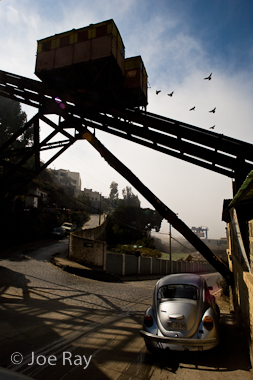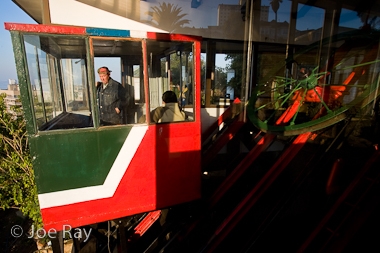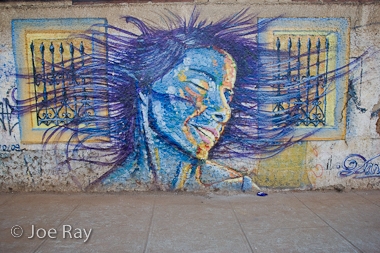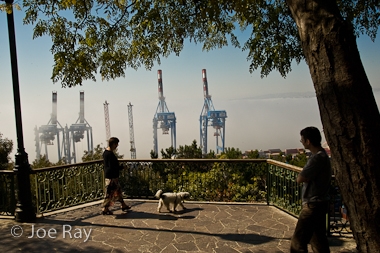Heart of the Hills
The Boston Globe - Travel - Sunday, July 27, 2008




A port city known for poetry, savory food, worldly influences, ValparaÃso has created itself
VALPARAÃSO - Pablo Neruda would be proud. Mere moments after arriving in the city the poet and Nobelist once called home, we set out to track down a mysterious lead and find the heart of this place by starting with its stomach.
Though ostensibly writing about himself in his “Autorretrato,” Neruda might as well have been writing about the quirky charms of ValparaÃso and its people.
For my part, I am, or believe I am . . .
. . . monumental of appetite, a tiger for sleeping,
quiet in joy, inspector of the nocturnal heavens,
invisible worker, persistently irregular . . .
With two friends, one a lifetime local, I head out to find an unmarked restaurant called Los Deportistas, named for its proximity to a soccer field. We buzz across the city’s ramshackle flat center in a pint-sized public bus, picking up the port’s dock and market workers along with uniformed grade-schoolers on their way home for lunch, getting an accidental slice of life as we go. Eventually we start the dizzying climb into one of the “cerros,” the hills that surround the center of town and create its distinct neighborhoods.
Up here, we find the homes that give the city its distinct look: beautiful, European-influenced architecture that often combines wood and brightly-colored corrugated metal. Perched on the hills, these homes - a little rusty, a little rickety - create a feeling that the city is held together with sticks and glue, yet that’s one of the keys to its beauty and charm.
While Santiago may be the business-centric capital (which can also be rather conservative and dull) and the country’s soul is reflected up and down its skinny, 2,600-mile strand of deserts, mountains, lakes, and farmland, ValparaÃso is Chile’s beating Bohemian heart.
The rest of the country can be buttoned-up, tight, tidy, and even occasionally moneyed, but “Valpo” is none of that; if you have a creative urge to feed, this is your town.
Like San Francisco in its hippie heyday, persistently irregular ValparaÃso is driven by the alternative and the artistic - a visual, cultural magnet for Chileans and centuries of adventurous expatriates who discovered the Pacific port city just before or after making their way around Cape Horn. While some world cities have corners that create a unique, authentic flavor, here, that magic is still blissfully spread across the entire town.
With a good dose of outside influence, a geography that forces creativity, and an atypical reputation that attracts a certain kind of Chilean, the city created itself on its own unique terms.
Back on the bus, the driver pulls over in the middle of residential nowhere, announcing our stop. The man who runs a newspaper and soda stand on the corner points us down the street to a two-story residential house that looks more like my Uncle Charlie’s old place in Des Plaines, Ill., than one of the best restaurants in town.
We stagger around in the street, looking upward, looking lost, searching for an outward indication that we are where we’re supposed to be: a sign hanging from the building, a plaque on the door - nothing. So I knock, wait, then open the door.
Jackpot.
A couple of school kids and a toddler in a Spider-Man costume, all of whom belong to the family that runs the place, swirl around at our feet. On a bar to the left are two trays of cooked tongue and a bottle of local honey liquor so thick, it’s tasted with a spoon. Across the room, two glass-fronted coolers house big, beautiful hunks of meat waiting to be grilled.
“How did you find us?” asks a kindly man who shows us through what could be called a “KGB supper club” atmosphere of partitioned rooms, white walls, fluorescent lighting, and tiny racks of flags that look like they’ve been pinched from a shelf at the old Pan Am airlines desk.
It’s all run by chef Ida Delgado, who is 80. Her kitchen is a rambunctious, oversized setup that takes up a room that may or may not have been the home’s original kitchen and spills out onto a partially-covered outdoor space where she does the grilling that makes the place famous.
“We have chicken and fish, but people come here for the meat,” says Delgado, making her way back to the coolers in the entryway. “This is my meat.”
She grabs a large chunk of beef with hands that, after a lifetime in the kitchen, look like custom butcher’s tools. “It goes fast,” she says, setting the meat on the table with a thud. “Chileans eat a lot of meat.”
Delgado is first and foremost devoted to her family and their restaurant, but she loves her town.
“On this side of town, I like the people, but on the other side, I don’t know,” she says, trailing off and making me wonder if I should be watching my back where I’m staying. Instead, Delgado is an extreme example of how tight and individual each of ValparaÃso’s cerro communities can be.
Lunch at Deportistas is a long, delicious, and weirdly charming affair and what is served to our trio takes up the better part of a table for eight. Delgado’s steak, which she imports from Uruguay and cooks on a big, blackened flat-top grill out back, is one of the finest of my life. Crusty, tender, meaty, juicy, and, unfortunately, not mine. I’ve ordered the tongue (still very good) and had a bite or two of my sweetie’s “bisteca.” As we tuck in, Delgado’s son Renato prepares a special vinaigrette, tosses the salad at the table, taps grated cheese from a spoon onto one of our dishes, and arrives later with second helpings, somehow gently convincing us that we still have space in our stomachs.
The experience will be par for the course in ValparaÃso only in that it is unexpected, strange, and wonderful.
After lunch, I retrace our path back across the town center, wander through labyrinthine streets and skinny stairways speckled with the town’s artistic graffiti murals, and end up at the bottom of the “ascensor” Cerro Alegre. In Santiago, about 70 miles away inland, it would be called a funicular, but with the near-vertical angle many of the cars climb and descend, ValparaÃso’s hallmark method of transportation is known succinctly as an “elevator.”
Atop the hill, seeing an old, black VW bug in a driveway and glowing lights in the home next to it, I stop into an artist’s gallery on a whim, and quickly understand that engraver Jorge MartÃnez GarcÃa is not aiming for the knickknack-seeking tourist crowd. GarcÃa’s is a deep and moody art. He is in back, printing a poster-sized etching of a landscape where even the contrasts between black and white in the hillsides are full of emotion.
“It’s like composing,” GarcÃa says of his craft, speaking as if we’ve met earlier and I have been there all day. Working with an assistant, he places a beautiful French paper over an etched, inked copper plate and turns a wheel to run a roller over the top, transferring the ink from one surface to the other.
“These aren’t copies, it’s different every time,” he says, gingerly lifting the paper to reveal the finished product, “Each one is a different interpretation.”
Although he’s presumably talking about his work, like Neruda, the lines between his life, his work, and his town never materialize.
“Each cerro is a barrio [each hill is a neighborhood]. They don’t exclude, but they give each neighborhood its own character - it’s improvised,” he says. “Here, you integrate into the geography you’re given. It forces a certain creativity. You’re obliged to create.”
Farther up the hill, I meet with Carolina Espinoza, who lives in ValparaÃso but spends several days a week teaching Chilean history and geography a few hours away in Santiago.
Espinoza began calling Valpo home a year ago for reasons that seem to be strange bedfellows: history and chaotic inspiration.
“It’s cosmopolitan here. ValparaÃso is built on this diversity,” she says, referring to the city’s expansive port, which made it an international shipping hub until the construction of the Panama Canal, and, after a period of adjustment, it remains so today.
This mix of cultures the city has attracted for centuries both contrasts with and parallels the geographic layout. Though the tiny downtown is on a grid plan like most other Chilean cities and towns, climb a few feet into the hills and that section of the city map looks like a cross-section of a rabbit warren.
“It’s always the most chaotic up here. The higher you go, the crazier it gets,” Espinoza says. Yet rising above downtown’s frenzy also has a calming effect. “People are cool - not too stressed out like in other cities,” she says of ValparaÃso’s inhabitants, called porteños like other port city residents. “Personally, I love to see things less squared-off, with the buildings stuck into the hillside. . . . People here know how to create a place that fosters creativity. When I moved here from Santiago, my body relaxed. I could breathe, my mind opened.”
Later, at the top of the ascensor El Peral, I talk with its operator, or “machinista,” who uses a steering wheel to control its five speeds and a hand brake like those found on a San Francisco cable car.
“This ascensor started working in 1902,” says Christian Salazar, who has been at the wheel for 12 years. “We didn’t have taxis or buses then. These came before everything.”
With the exception of switching from vapor to electric power, the El Peral ascensor functions much like it did when it opened more than 100 years ago. The communication Salazar has with the station at the bottom relies on a system of lights - no phone, no radio. “When the lights are on, they’re ready to go,” he says.
“This belongs to the state, but it’s a part of the city,” he says, with downtown at his feet and several hills rolling up and down through the horizon as he gently brings the two cars to a halt (a ride costs about a quarter). “Up top is where you control it. Down below, you just shut the door and hit the light.”
There it is - top and bottom, foreign and local, old and new, all linked by an ascensor.
Farther up the hill, GarcÃa agrees. “People know the city is special and open up and give it their own energy,” he says, “It opens people’s imagination. It resonates.”
IF YOU GO
What to do
Bring walking shoes, a sketchbook, and an open mind. The historic port city is made for wandering and often is best understood by simply enjoying the view. Many hotels will have walking maps for guests.
La Sebastiana Ferrari
692 011-56-32-256-606
fundacionneruda.org
One of Pablo Neruda’s three homes in Chile, as quirky as ValparaÃso and the Nobel poet himself. Tuesday-Sunday 10 a.m.-6 p.m.
Jorge MartÃnez GarcÃa’s studio
Lautaro Rosas
330 011-56-32-249-8784
jorher.com
See the artist’s moody engravings, paintings, and monotypes and watch him work at his gallery-studio in the Cerro Alegre.
Where to stay
B&B La Nona
660 011-56-32-249-5706
bblanona.com
There’s no sign for this bed-and-breakfast. Low-key and friendly, with great feel-at-home touches like an old, red radio playing in the bathroom. About $25 per person per night.
Zero Hotel
Lautaro Rosas
343 011-56-32-211-3113
Terraces, gardens, views of the bay, and only nine rooms in this trendy and well-thought-out “homescape.” $170-$265 per night.
Where to eat
Los Deportistas
1217 011-56-32-237-5159
Lunch daily 1-4 p.m., dinner Wednesday-Friday starting at 8 p.m. About $20 for a huge meal, including one of the best steaks of your life and a tasty house wine.
Delicatessen Emporio
383 011-56-32-233-9373
The front edge of food in Chile. One dish combines local clams with Spanish chorizo. $20-$40 for a full meal.